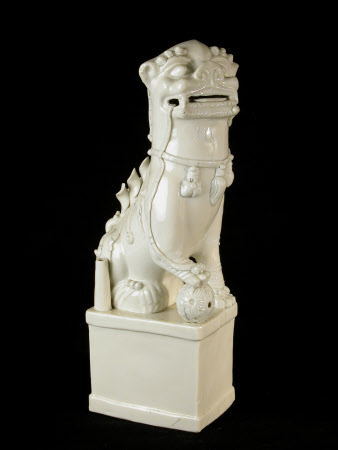Incense burner
Category
Ceramics
Date
1662 - 1722
Materials
Porcelain
Measurements
345 x 85 x 120 mm
Place of origin
Dehua
Order this imageCollection
Saltram, Devon
NT 870824
Summary
Pair of incense burners, porcelain, made in Dehua, Fujian province, China, Kangxi period (1662–1722), representing Buddhist lions seated on rectangular plinths, both holding a ball under one paw, with an upright tube at one corner of each pedestal to hold an incense stick.
Full description
The white undecorated porcelain produced in Dehua is sometimes called blanc de Chine (‘Chinese white’) in the West. Likewise, Buddhist lions are sometimes called ‘dog of Fo’ or ‘dog of Fu’ in the West, after the Mandarin word for ‘Buddha’ or ‘Buddhist’, 佛 Fu. The fantastical appearance of these figures is partly explained by the fact that Chinese artisans would not have known real lions. The pedestals are an echo of the practice of placing large lion figures as guardians next to entrances to temples. Similar Dehua figures of Buddhist lions are in the collections at Blickling Hall (NT 353355.1-2, NT 353486), Chirk Castle (NT 1170561.1-2), Lacock Abbey (NT 995781), Penrhyn Castle (NT 1420460.1-2), Stourhead (NT 730491.1-2), Uppark (NT 137438.1-2) and Wallington (NT 581819.1-2, NT 581823.1-2, NT 581838). There are also several in the British Royal Collection, RCIN 58864 – RCIN 58867, probably acquired by King George IV when Prince of Wales in the early 19th century.
Provenance
Accepted by HM Government in lieu of inheritance tax and allocated to the National Trust, 1957.

